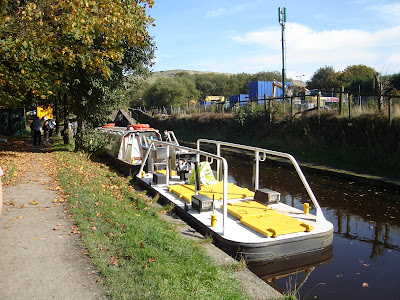Unusually I was not rostered on any Concorde tours this weekend, so I took the opportunity to travel down to the National Exhibition Centre at Birmingham International intending to visit 'The Flying Show' in Hall 12 and 'Motorcycle Live' in Hall 2.
A Virgin West Coast Pendelino took me from Wilmslow to Crewe, a London Midland 350 electric multiple unit conveyed me onwards to Birmingham New Street, and a second one took me on to Birmingham International arriving about 10:15. From the station it's fair walk to Hall 12 but hey, the exercise would do me good.
So I got into the front seat, donned the headset so i could talk to the back seater, who positioned us in a 40 knot cruise about 1,500 ft above the floor of an alpine valley with an airfield below us. I lowered the nose for 120 knts, eased back the stick, and the glider looped very nicely, the Alpine scenery disappearing below the nose to be replaced by sky, then reappearing from above. Using the exit energy from the loop I waited for about 30 degrees nose-up, and then and rolled it; "I don't think it'll roll" came the voice in the headset. But it did, and surprisingly well, too. We were below the sides of the quite narrow valley now with the airfield behind us, so I lowered the nose again and pulled up for a half-loop with a roll off the top (which it just managed!) to reverse our direction of travel and position us high downwind right hand for the runway. I extended downwind for a while until the runway was (I had to guess of course) 'over my right shoulder' and started a gentle right turn towards final approach. I kept the circuit tight and using airbrake kept a high rate of descent as I reefed it round a tight-ish turn onto a short final. But I overdid the airbrake and touched down gently, wings level, on the centreline and runway heading, but just short of the runway threshold which the computer interpreted as a crash! "Oh dear" said the voice, "and it was all going so well. Nice aeros, though".
He took the pressure chart for midnight last night as his example, and it showed a lot of features he wanted to talk about. In particular a low pressure system (989) in the Atlantic is sending an almost straight (note the isobars) west south westerly flow to the British Isles. This low and indeed that flow are directly below the jet stream, and as a result that low will deepen considerably as it moves east, bringing very very high winds to Scotland.
Also shown on the chart are some high pressure systems, and the fronts; warm fronts, cold fronts, occlusions, and troughs. Simon explained the characteristics of each of these, confirming that some lovely flying weather can be had just after a cold front or a trough has gone through.
































































